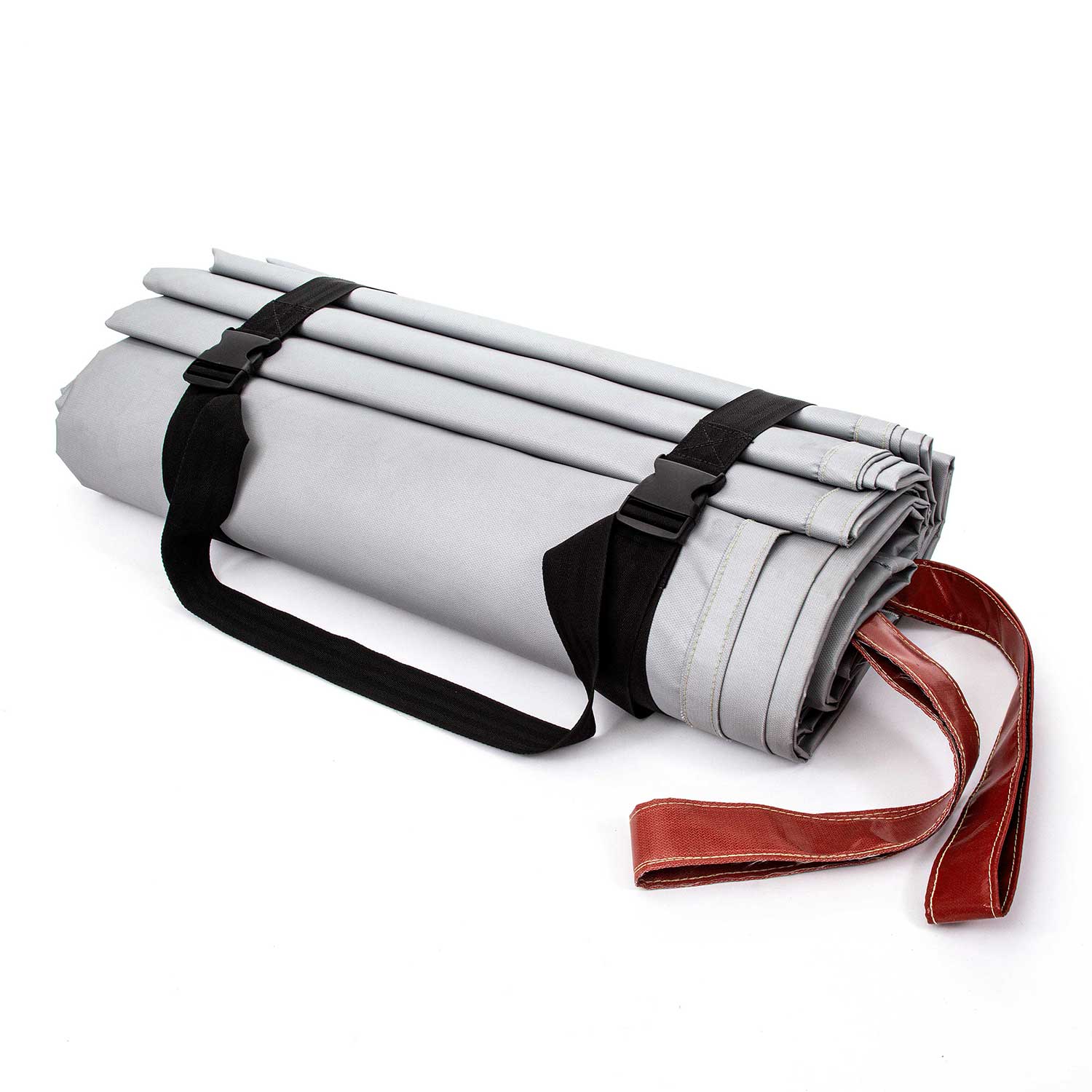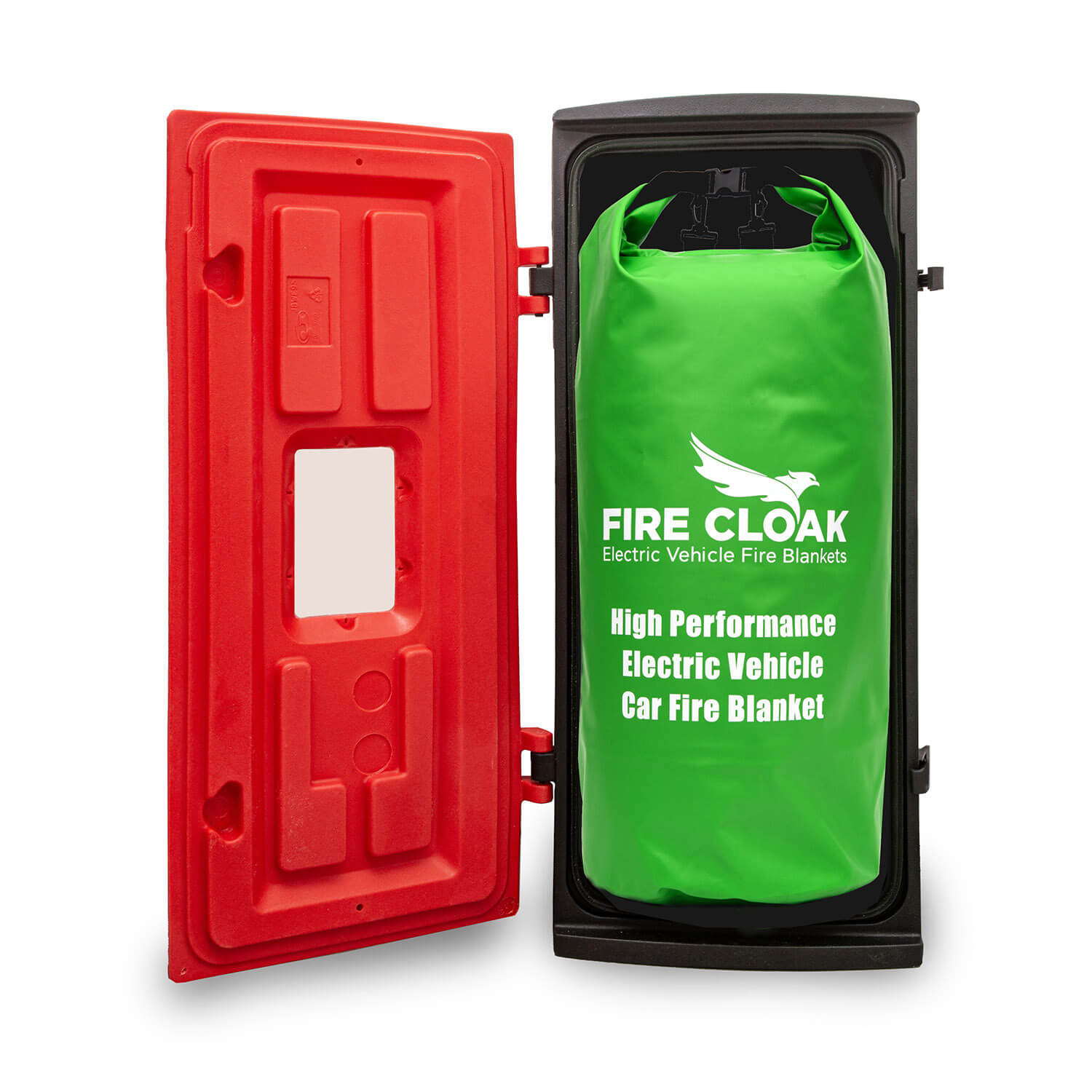Designed to contain Electric and Hybrid Vehicle fires, the EV Car Fire Blanket has been developed after many months of research and development.
The most common form of fire in electric or hybrid vehicles is when the high energy battery is damaged, or a manufacturing fault results in a short circuit. The battery can then go into “Thermal Runaway”, this is a phenomenon where damaged cells heat up rapidly to such an extent that a fire starts. The fire then compromises adjoining cells and a “domino effect” occurs spreading to the whole battery array.
Thermal Runaway fires cannot be extinguished by conventional means!
The electrolyte in a Lithium-Ion battery usually contains hydrocarbon solvents which fuels the fire. If unchecked extremely high temperatures can result.
Utilising an EV Car Fire Blanket minimises the combustion potential by depriving the fire of Oxygen. This inhibits the fire and consequently temperatures drop rapidly, reducing potential damage to surrounding vehicles and property.
The EV Car Fire Blanket can be deployed easily by two people and is supplied in a convenient storage holdall for protection and ease of transport.
Product Description:
Specially modified glass fibre fabrics (FBM1290 colour: GREY and FBM1291R colour: RED) with fire resistant silicone coating to both sides.
Fabricated with four lengths, of FBM1290 (Grey) and one central length of FBM1291R (Red) to confirm correct positioning during deployment.
6 x heavy-duty, fire resistant pull handles one to each corner and centrally on both of the long sides, with triple layer reinforced mounting points on all handles.
All seams and handles stitched with high temperature resistant thread.
Dimensions: 12 x 9 metres – Weight: c.33kg. (includes storage bag)
| Property | Units | Value | Tolerance |
|---|---|---|---|
| Weight | g/m2 | 200+60 | ± 5% |
| Silicone Coating | g/m2 | 30 (each side) | ± 10% |
| Tensile Strength – Warp | N | 1000 | ± 2% |
| Tensile Strength – Weft | N | 920 | ± 2% |
| Tear Strength | N | >128 | ± 2% |
| Burst Strength | kPa | >1000 | ± 4% |
Base Material FBM1290 and FBM1291R Test Data:
BS 476-20/22 1987 (similar to USA standard ASTM E119): Indicative Furnace Test – Resisted 1,000°C (1,832°F) for 90 minutes, at which point the test was stopped.
D6413 / D6413M-22: USA standard for Vertical Flame Resistance – PASSED with Best Possible Result.
NFPA 701: USA standard for Flame Propagation of Textiles – PASSED and NFPA certified.
ISO EN 13501-1 2018: European Standard for Fire Classification of Products – Rating: A2, s1, d0
FUTURE TESTING – commencing November 2024
• Intertek Testing Services (UK) Ltd: To assess Oil / Hydrocarbon Resistance, Air Permeability and a Hydrostatic Pressure Resistance.
• Horiba MIRA (Motor Industry Research Association, Nuneaton, UK): Another “Live Burn” test where the Fire CloakTM XL Fire Blanket will be deployed over a Large EV Panel Van after being forced into an advanced stage of Thermal Runaway.
Designed to contain Electric and Hybrid Vehicle fires, the EV Car Fire Blanket has been developed after many months of research and development.
The most common form of fire in electric or hybrid vehicles is when the high energy battery is damaged, or a manufacturing fault results in a short circuit. The battery can then go into “Thermal Runaway”, this is a phenomenon where damaged cells heat up rapidly to such an extent that a fire starts. The fire then compromises adjoining cells and a “domino effect” occurs spreading to the whole battery array.
Thermal Runaway fires cannot be extinguished by conventional means!
The electrolyte in a Lithium-Ion battery usually contains hydrocarbon solvents which fuels the fire. If unchecked extremely high temperatures exceeding 1,200°C+ can result.
Utilising an EV Car Fire Blanket minimises the combustion potential by depriving the fire of Oxygen. This inhibits the fire and consequently temperatures drop rapidly, reducing potential damage to surrounding vehicles and property.
The EV Car Fire Blanket can be deployed easily by two people and is supplied in a convenient storage holdall for protection and ease of transport.
Product Description:
Specially modified glass fibre fabrics (FBM1290 colour: GREY and FBM1291R colour: RED) with fire resistant silicone coating to both sides.
Fabricated with four lengths, of FBM1290 (Grey) and one central length of FBM1291R (Red) to confirm correct positioning during deployment.
6 x heavy-duty, fire resistant pull handles one to each corner and centrally on both of the long sides, with triple layer reinforced mounting points on all handles.
All seams and handles stitched with high temperature resistant thread.
Dimensions: 12 x 9 metres – Weight: c.33kg. (includes storage bag)
| Property | Units | Value | Tolerance |
|---|---|---|---|
| Weight | g/m2 | 200+60 | ± 5% |
| Silicone Coating | g/m2 | 30 (each side) | ± 10% |
| Tensile Strength – Warp | N | 1000 | ± 2% |
| Tensile Strength – Weft | N | 920 | ± 2% |
| Tear Strength | N | >128 | ± 2% |
| Burst Strength | kPa | >1000 | ± 4% |
Base Material FBM1290 and FBM1291R Test Data:
BS 476-20/22 1987 (similar to USA standard ASTM E119): Indicative Furnace Test – Resisted 1,000°C (1,832°F) for 90 minutes, at which point the test was stopped.
D6413 / D6413M-22: USA standard for Vertical Flame Resistance – PASSED with Best Possible Result.
NFPA 701: USA standard for Flame Propagation of Textiles – PASSED and NFPA certified.
ISO EN 13501-1 2018: European Standard for Fire Classification of Products – Rating: A2, s1, d0
FUTURE TESTING – commencing November 2024
• Intertek Testing Services (UK) Ltd: To assess Oil / Hydrocarbon Resistance, Air Permeability and a Hydrostatic Pressure Resistance.
• Horiba MIRA (Motor Industry Research Association, Nuneaton, UK): Another “Live Burn” test where the Fire CloakTM XL Fire Blanket will be deployed over a Large EV Panel Van after being forced into an advanced stage of Thermal Runaway.

















